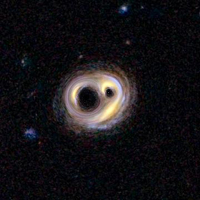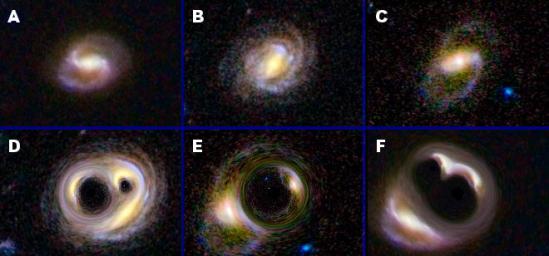
Figure 1
Click on the image for larger versionCan you match each galaxy in the top row with its warped counterpart in the bottom row? For example, is the warped version of galaxy A in box D, E, or F? Answers are at the bottom of this caption.
Such galaxy warping occurs naturally in nature in a phenomenon called strong gravitational lensing. The gravity of matter in front of a more distant galaxy, either dark or normal matter, bends and twists the galaxy's light, resulting in wacky shapes and sometimes multiple versions of the same galaxy. It's like seeing a galaxy in a funhouse mirror. Scientists use these natural lenses to make maps of dark matter, an invisible substance permeating our cosmos. The lenses also help in the study of dark energy, an even more mysterious substance thought to be pushing universe apart at increasing speeds.
This quiz demonstrates extreme cases of gravitational lensing. The warped images have been simulated from original images of galaxies taken by NASA's Hubble Space Telescope. Galaxy E shows what is called an "Einstein ring," named after Albert Einstein, who discovered that gravity bends light. In this case, the mass of one body, a lump of dark matter, has twisted the galaxy's light into a ring. In the other two cases, two lensing sources create double-ringed structures.
In reality, most lenses are not this obvious. In what is called weak gravitation lensing, the effects are subtle and hard to tease out. Scientists have created a competition called GREAT3, which stands for GRavitational lEnsing Accuracy Testing 3, to improve methods for measuring weak lensing. Data scientists from an assortment of fields, including machine learning, are invited to solve galaxy puzzles, in which tiny lensing affects have been artificially introduced by the organizers of the challenge. The goal is to figure out what the lensing affects are, and in doing so, help develop new tools for probing the dark side of our cosmos.
GREAT3 is sponsored by NASA's Jet Propulsion Laboratory, Pasadena, Calif. and a European Union Network of Excellence called Pattern Analysis, Statistical Modeling and Computation Learning 2 (PASCAL2).
Answers to quiz: A matches F; B matches D; and C matches E.

 Planetary Data System
Planetary Data System













